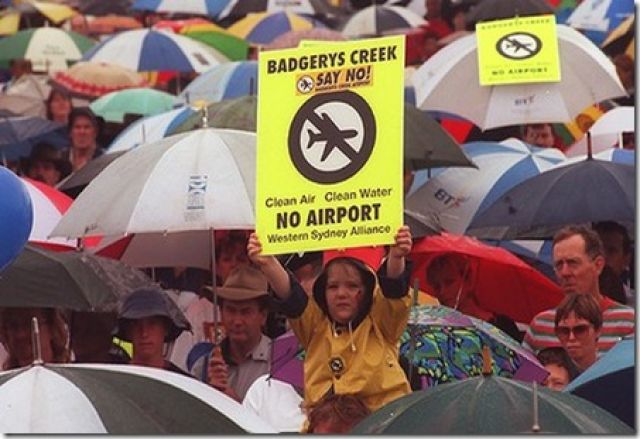
Newly appointed foreign minister Bob Carr said in a January blog post: “As [NSW] Premier, I never saw a demonstration that didn’t hurt the side that mounted it. And I was never persuaded by a noisy crowd with a few placards.”
But on March 2, the same week he was appointed, the federal government gave a powerful confirmation of the power of protests.
Federal infrastructure and transport minister Anthony Albanese said Badgerys Creek in Sydney’s west was not the preferred site for a second airport for Sydney. This was despite a 3000 page study that recommended it as the best option.
The only possible explanation for this was that it was a political calculation on behalf of the federal government, which remembers the fierce campaign lead by Badgerys Creek residents against the airport in 1998.
Green Left Weekly reported at the time: “An estimated 8-10,000 people braved inclement weather to attend a rally against the proposed second Sydney airport at Badgerys Creek on March 15. An alliance of western Sydney local councils organised the rally at Jamieson Park in Penrith, in Sydney's far west.”
It seems the campaign has won. So far, so good. But the devil is in the detail. The new preferred site is Wilton, a small town 30 kilometres north-west of Wollongong with a population of about 1300.
The residents of Wilton have done this dance before. An airport was planned for the town in the mid ’80s but was met with stiff resistance and the group Wilton Airport Resistance (WAR). The Illawarra Mercury said on March 5 that only two residents in the town supported the airport at the time. One has now changed his mind.
WAR’s case was strengthened immeasurably by a 1985 environmental impact statement. Followed up in '99, the report showed most of the site is in a water catchment area for Sydney and Wollongong, and all run-off will flow into local waterways.
A local resident told the Mercury: “The bushfire brigade can't even use flame retardants — they have to use plain water because everything disappears into the creeks and the catchment area.”
The area is also mostly a native forest of high ecological value that is home to many protected species.
It is for these reasons that the residents of Wilton think the airport won’t go ahead. The local liquor shop owner told the Mercury: “It's our drinking supply; they're not going to pollute it — unless they are stupid.”
Yet governments across the country have rolled out the welcome mat to the coal seam gas industry, a direct threat to water supplies.
Airplane fuel leaking or being dropped into the water supply and the accompanying noise that will affect the northern suburbs of Wollongong — many of who already have to deal with coal trains hurtling past their houses — aren’t exactly selling points.
The mayors of Camden, Campbelltown and the Wollondilly shire, Wilton’s local council area, have come out strongly against the plan. Wollongong's mayor has seriously questioned the plan.
Two Illawarra MPs, Labor's Sharon Bird and Ryan Park, have told the Mercury the environmental impact study will ensure Wilton isn’t pursued as an option.
So supporters of the airport plan are talking up other issues. A particularly potent argument relies on job creation. Unemployment is high in the Illawarra, and building the airport will supposedly create 1000 jobs, increase tourism and lead to investment in other much-needed infrastructure.
The airport will cost about $11 billion. No doubt this would create jobs. But so would such a huge investment in any project, and could be done with far less cost to the environment.
Another alternative to a second airport is for flights to go to Canberra, which could be linked to Sydney by a bullet train that could make travel time about 50 minutes between the cities.
This has been called for by Canberra airport's managing director. High-speed rail between Melbourne and Sydney, including a stop in Canberra, would cost about $61 billion. Putting the aiport's $11 billion towards this would create more jobs and also be socially useful.
This would also be a better investment for tourism as well. Good places to live are usually the best places to visit. One of the reasons why Europe is so attractive to travellers is the efficiency of its public transport.
Eddy de Gabriele of Regional Development Australia Illawarra supported the Wilton plan.
ABC online said on March 5 that de Gabriele linked the construction of the Wilton airport to the completion of the Maldon-Dombarton rail link, upgrades to Picton Road and a high-speed rail network.
This is a form of moral blackmail. These are incredibly popular infrastructure projects in contrast to the airport plans. De Gabriele said, in effect, that to get a safe road or better public transport, communities will need to accept potential contamination of their water supply.
But communities aren’t as stupid as the government and won’t be willing to compromise their water supply. Nor does it seem likely that people will accept residents being moved out of their homes for an airport.
There was a reason that the film The Castle was so popular. The government needs to stop flirting with approving another project that threatens our water supply and start investing in sustainable solutions, such as a high-speed rail network.
